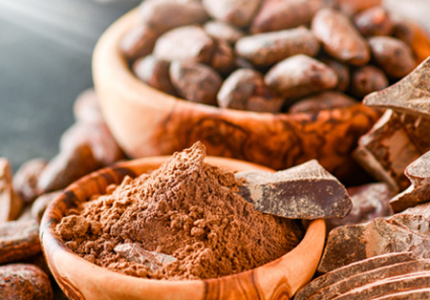High-fat cocoa powder, medium-fat cocoa powder, and low-fat cocoa powder according to the content of raw cocoa butter bulk. There are different standards between national standards and industry standards, and generally we refer to industry standards. In the national standard, the cocoa butter content of natural high fat cocoa powder is ≥20.0%, the cocoa butter content of medium-fat cocoa powder is 14.0%-20.0% (excluding 20.0%), and the cocoa butter content of low-fat cocoa powder is 10.0%-14.0% (excluding 14.0%).
What the industry calls high-fat cocoa powder has a cocoa butter content of 20.0%-24.0%, the cocoa butter content of medium-fat cocoa powder is 10.0%-12.0%, and the cocoa butter content of low-fat cocoa powder is 8%.
Natural process cocoa powder and alkalised cocoa powder according to the alkalization process. Alkalized cocoa powder is further divided into light alkalized cocoa powder and heavy alkalized cocoa powder.
Cocoa black powder, brown cocoa powder, and pure alkalized cocoa powder. Skyswan also manufacturer red alkalized cocoa powder at a competitive wholesale price.
West African cocoa powder, Indonesian cocoa powder, and so on.
Natural cocoa powder is light brown cocoa powder produced from cocoa beans during processing without adding any additives; while alkalized cocoa powder is the result of adding food alkali during the processing of cocoa beans to adjust the pH value, which deepens the color of cocoa powder and enhances its aroma compared to natural cocoa powder. This difference is from the processing process, which is generally difficult for ordinary people to distinguish. The following are compared from the aspects of use and appearance.
The color of natural cocoa powder is lighter than that of alkalized cocoa powder, and the aroma is not as strong as that of alkalized cocoa powder. In terms of usage, alkalized cocoa powder has a wider range of applications. Generally speaking, natural cocoa powder is not used in the production of liquid products because its solubility is around 30%; alkalized cocoa powder can be used in the production of any food, and can also be directly consumed. Because the cost of alkalized cocoa powder is higher than that of natural cocoa powder, food manufacturers usually use natural cocoa powder for solid products, while alkalized cocoa powder is used for liquid products such as milk and beverages, cocoa powder suitable for vegans. Chocolate on the market is generally made from natural cocoa powder, while chocolate-flavored milk tea is made from alkalized powder.
There is another important difference between natural cocoa powder and alkalized cocoa powder, which is the pH value. The pH value of natural cocoa powder is generally between 5.0-5.8; the pH value of alkalized cocoa powder is generally between 6.2-7.5.


